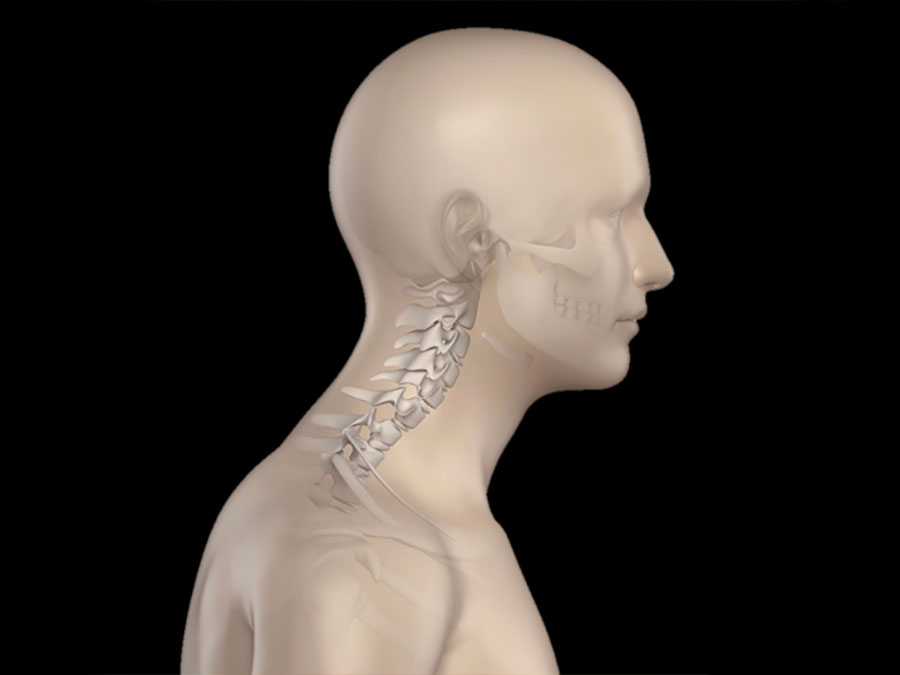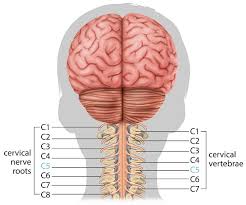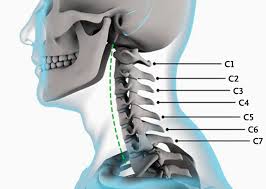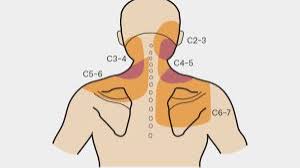

The article, “How my forward neck posture affected my C5 vertebrae” is an extension to the series of articles describing the impact of my nerd neck on my cervical vertebrae.
It is not just the C1 or the C2 vertebrae that is vital for optimal head and neck functionality. In reality, each of the 7 vertebrae present in your neck are vital and all of these are impacted adversely when you slide your head forwards.
Each of these 7 vertebras has its own distinctive feature, role and function. If any of these are compressed, pinched, stretched or stressed, they shall impact your head and neck posture.
In fact, your life can literally become a “living hell” if your cervical spine vertebras are not in their prime health.
This (living hell) is experienced best in the form of aches, pains, stiffness and lack of flexibility in the muscles of the neck, upper back, shoulders and also parts of the middle back area.
So, let me walk you through how my forward head posture damaged my C5 cervical vertebrae in brief!
Article Index: “How My Forward Neck Posture Affected My C5 Vertebrae”
1) How does My C5 Vertebrae Looks Like?
2) What are the Main Functions of My C5 Cervical Vertebrae?
3) How My Bad Neck Posture Affected My C5 Vertebrae?
5) FAQs on C5 Vertebrae and Forward Neck Posture
4) My Road to Recovery
How does My C5 Cervical Spine Looks Like?
Ah, the C5 vertebra—a little bony gem in the treasure chest of my spine!
Nestled snugly in the middle of my cervical spine, the C5 vertebra is the fifth segment of my neck’s bony backbone.
Imagine a stack of tiny, delicate building blocks starting right at the base of my skull, and you’ll find C5 sitting comfortably in the fifth position, like the cool kid in the middle of a class photo.
The cervical spine consists of seven vertebrae, labeled C1 to C7. The C5 vertebra lies between the C4 and C6 vertebrae, right in the middle of my neck.
It’s part of the cervical curve that helps support my head, which, let’s face it, is no small feat considering the constant flow of ideas and dreams inside!
According to Darden et al. (2001), the cervical spine is the most mobile segment of the spine, which means my C5 is quite the flexible friend, contributing to the neck’s range of motion.
Not to brag, but my C5 vertebra also acts as a protective guardian for my spinal cord, sitting pretty in the vertebral foramen like a knight in shining armor.
This bony structure safeguards important nerves that travel to my shoulders, arms, and hands.
So, the next time I nod my head in agreement or shake it in dismay, I know my C5 is doing its job splendidly!
Who knew one little bone could be so integral to my daily life?
What are the Main Functions of My C5 Cervical Vertebrae?
My C5 vertebra—a true unsung hero in the neck, doing much more than just holding up my head like a glamorous hat stand.
Let me take you on a fun-filled journey through the exciting world of the C5 vertebra and its marvelous functions.
The Structural Support Superstar:
The C5 vertebra is like the architectural wonder of my cervical spine, providing structural support and stability to my neck.
Positioned between C4 and C6, it’s part of the mighty cervical curve, which helps maintain proper alignment and balance in my spine (Pal et al., 2012).
It’s like a sturdy pillar that ensures my head doesn’t topple over during those intense brainstorming sessions.
Without the C5, I’d be a wobbling bobblehead, and nobody wants that!
The Motion Maestro:
Did you know that the C5 vertebra plays a key role in the mobility of my neck?
As per BestForwardHeadPostureFix research, “It is like a dance maestro, orchestrating a graceful symphony of movements”. The cervical spine, including the C5, allows me to nod in agreement, shake my head in disbelief, and swivel around like a confused owl at a party.
According to Bogduk (2009), the C5 contributes to the impressive range of motion in my neck, giving me the flexibility to look up, down, and all around.
The Nerve Network Guardian:
The C5 vertebra is a true guardian of my nervous system, protecting the delicate spinal cord that runs through it.
This bony shield helps safeguard important nerves responsible for sending signals to my shoulders, arms, and hands (Alberts et al., 2012).
It’s like having a highly efficient communications network that ensures I can wave hello, lift groceries, and even execute the perfect high-five!
The Shock Absorption Champ:
Let’s not forget the C5’s ability to absorb shocks like a seasoned trampoline artist.
It helps cushion the impact of everyday activities, like walking, running, lifting a heavy suitcase or spontaneously dancing to my favorite tunes.
According to White and Panjabi (2010), this shock-absorbing feature of the C5 is essential for protecting my neck and maintaining comfort during various movements.
Here is My Opinion:
In my opinion, the C5 cervical vertebra is a multifaceted marvel, playing crucial roles in support, mobility, protection, and shock absorption.
It is like a multitasking superhero, ensuring my neck remains a well-functioning and flexible part of my body.
So, here’s to the C5—my neck’s steadfast guardian and an unsung champion of everyday life!
How My Bad Neck Posture Affected My C5 Vertebrae?
Bad neck posture is undoubtedly the silent saboteur of my C5 vertebra!
It sneaks up like a mischievous gremlin, wreaking havoc when I’m least aware.
Who knew that my habit of craning over screens like a digital detective could lead to a neck rebellion?
Let me take you on a journey through the effects of poor neck posture on my C5 vertebra, and how I finally tamed this unruly beast.
The Silent Saboteur: Forward Head Posture
Let’s talk about forward head posture, the modern-day affliction caused by endless hours of texting, typing, and binge-watching.
When my head juts forward like a curious turtle, it puts extra strain on my C5 vertebra. This posture increases the weight on my neck by about 10 pounds for every inch the head moves forward (Kapandji, 1974).
It is like having an invisible bowling ball hanging from my neck! The poor C5 struggles to support the extra load, leading to pain and discomfort. My once-proud neck became a sorry victim of my tech-driven lifestyle.
The C5 Strain: A Real Pain in the Neck
As my C5 vertebra bore the brunt of my poor posture, it started sending out distress signals in the form of neck pain, stiffness, and headaches (Griegel-Morris et al., 1992).
The prolonged stress on my cervical spine compressed the C5 nerve root, which caused numbness and tingling sensations down my arms (Magee, 2013).
My body was speaking up, and it was time I listened!
The Road to Recovery: Correcting My Posture
Once I realized that my C5 vertebra was tired of being the victim, I embarked on a mission to improve my neck posture.
I started practicing exercises (such as sphinx pose and child’s pose) to strengthen my neck and upper back muscles, and invested in an ergonomic workstation (Ludwig et al., 2018).
Gradually, my C5 began to feel like its old self again. I embraced good posture like a newfound friend, and my neck thanked me with relief and comfort.
This is What I Learnt:
In conclusion, my bad neck posture was like a prankster playing tricks on my C5 vertebra, but I took back control with a few simple changes.
The key takeaway?
Awareness and mindfulness are crucial to keeping my C5 happy and healthy.
So, here is to standing tall, aligning my spine, and banishing the neck gremlin for good!
FAQs on C5 Vertebrae and Forward Neck Posture
Q1: How does forward neck posture affect the C5 vertebra?
A1: Forward neck posture, or “nerd neck,” places additional stress on the cervical spine, particularly the C5 vertebra. This misalignment can lead to increased compressive forces on the intervertebral discs and facet joints at the C5 level, potentially accelerating degenerative changes and causing pain.
Q2: Can forward head posture lead to nerve compression at the C5 level?
A2: Yes, prolonged forward head posture can narrow the intervertebral foramen at the C5 level, compressing the spinal nerves. This compression may result in symptoms such as pain, numbness, or weakness radiating down the arm, commonly referred to as cervical radiculopathy.
Q3: How does forward neck posture influence muscle function around the C5 vertebra?
A3: Maintaining a forward head position can lead to muscle imbalances around the C5 vertebra. The deep cervical flexors may become elongated and weakened, while the upper trapezius and levator scapulae muscles may become shortened and tight. These imbalances can contribute to discomfort and reduced range of motion in the neck.
Q4: What are the long-term effects of forward neck posture on the C5 vertebra?
A4: Over time, sustained forward head posture can lead to chronic stress on the C5 vertebra, increasing the risk of degenerative disc disease, facet joint arthritis, and the formation of bone spurs. These conditions can cause persistent neck pain and limit mobility.
Q5: How can correcting forward neck posture benefit the C5 vertebra?
A5: Addressing forward head posture through exercises, ergonomic adjustments, and posture correction can alleviate stress on the C5 vertebra. This correction may reduce pain, improve muscle function, and decrease the risk of developing degenerative changes in the cervical spine.
My Road to Recovery
Recovering my C5 vertebra from the clutches of bad neck posture was like orchestrating a symphony of wellness and alignment.
The first step was acknowledging that my posture was more sloth than soldier, and my neck was paying the price.
With determination and a sprinkle of humor, I embarked on a mission to rescue my beleaguered vertebra.
I started by becoming best friends with ergonomics, adjusting my workspace to promote a neutral spine position.
My monitor rose to eye level, and my chair supported me like a loyal companion.
Regular breaks became my new mantra, stretching and moving to remind my C5 that it didn’t have to carry the world’s weight alone.
Exercise was next on the agenda.
I incorporated neck stretches and strengthening exercises to build resilience in the muscles supporting my cervical spine.
Yoga and pilates became my go-to, encouraging flexibility and posture awareness.
Mindfulness was the cherry on top.
By practicing mindfulness, I learned to check in with my posture regularly and adjust as needed.
The transformation wasn’t instant, but over time, my C5 vertebra felt less like a creaky hinge and more like a well-oiled machine.
My neck was happy, my posture was proud, and I could finally bid farewell to those pesky neck gremlins!
References:


